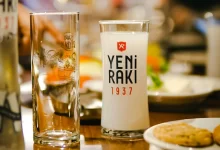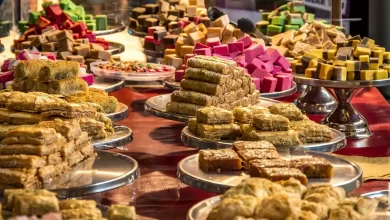Turkish food culture
Savoring Tradition: Exploring the Rich Tapestry of Turkish Food Culture

Turkish food culture
The cultural features of the Ottoman Empire cuisine, the culture of the Balkans, and the Middle East have had a tremendous impact on Turkish cuisine, which also shows differences in Turkish cuisine according to region. Regions such as the Black Sea, Southeast, and Central Anatolian food cultures have rich food sources for themselves.
The strength of Turkey’s tourism industry, along with this issue, has led to Turkish cuisine earning recognition as one of the world’s most prominent and delicious foods. The Ottoman food heritage emerged from the amalgamation of diverse cooking methods and raw materials from Central Asia, the Caucasus, the Middle East, the Mediterranean, and the Balkans, giving it a multicultural structure.

Food preparation methods, which have different flavors from one region to another, have different meanings and even sanctity on special days, festivals, and ceremonies. Turkish cuisine includes a variety of foods and drinks that can be a source of healthy and balanced nutrition, including vegetarian foods, which are different in terms of variety and taste.
Because of its extensive use of vegetables, fresh fish, and olive oil, experts consider Turkish cuisine one of the richest in the world. The most commonly used ingredients in Turkish cooking are meat, vegetables, and beans. Because watery and stewed foods are commonly used, bread is also widely consumed in Turkey.
- Marmara region cuisine
- Mediterranean cuisine
- Aegean cuisine
- Foods of the Black Sea region
- Central Anatolian cuisine
- Eastern Anatolian cuisine
- Southeast Anatolian cuisine
The position of kebab in Turkish food culture
Meat dishes in the culture of Turkish cuisine include kebabs, meatballs, and pans.
Kebabs hold a special place in Turkish food culture and undergo various preparations. Apart from these kebabs, rice, bulgur, and vegetables are also served, tailored to each region of the country, depending on the ingredients and cooking method. Turkey has this type of preparation and different servings and recipes specific to that region.

In Turkish cuisine, kebab means the meat itself or in the form of lahmajun, which is very similar to pizza. In general, kebab in Turkish cuisine culture refers to foods eaten in restaurants and prepared by the grill method. Doner kebab is one of the most popular kebabs. In addition, skewered kebabs such as Kebab Bursa, Kebab Adana, Kebab Orfa, Kebab Tokat, and Pirzola (ribs of kebab or T-bone) are also very common in Turkish cuisine culture.
People make meatballs by kneading minced meat with breadcrumbs, onions, and various spices. They can grill, bake, fry, or stew them to achieve different flavors and textures.
Popular Turkish meatballs
- Akçaabat
- Inegöl Meatballs
- Tekirdag
Among juicy meat dishes, we can mention Güveç, Kağıt Kebabı, and various stews. Also, dishes with fish, meat, chicken, and offal are abundant in the culture of Turkish cuisine.
Soup in Turkish food culture
Soup is an integral part of Turkish cuisine, especially in winter.
The best soups of Turkish food culture
- Mercimek çorbası (lentil soup)
- Ezogelin çorbası (Ezogelin soup)
- yoğurt çorbası (yogurt soup)
- tarhana çorbası (Tarkhaneh soup)
However, Turkish cuisine includes many other soups that use meats, vegetables, and legumes. Meat broth, flour, yogurt, and vermicelli turn these ingredients into soup.

It is widely believed that sour soup is helpful for headaches caused by alcoholic beverages after drunkenness. Restaurants that serve gizzards and gizzards (cow gizzard soup) stay open late, especially in cities, and serve soup to customers who crave gizzard soup.
The place of vegetables in Turkish food culture
Turkish cuisine is very diverse in terms of vegetable consumption. Stuffed vegetables, vegetables in meat dishes, fried vegetables, and vegetable dishes with olive oil are available in countless varieties. Of course, Turkey’s vegetables may differ slightly from those used in other countries.

What is the difference between Delma and Sarma?
Dolmas fall into two categories: flattened dolmas, known as Sarma, and stuffed dolmas. Delma and Sarma can be prepared with or without meat. Stuffed dolmas typically contain minced meat, rice, onion, tomato paste, pepper, and various spices. Conversely, dolmas without meat, known as Yalancı dolma (false dolma), are made using rice, onions, raisins, and pine nuts. Sarma dolmas are made using cabbage, and vine leaves are wrapped around them. The most common vegetables used for dolmas stuffed with minced meat include bell pepper, zucchini, tomato, eggplant, and onion.
Various dishes combine vegetables with meat, such as beans with beef, ribs, eggplant, pumpkin with beef, lentils, peas with meat, spinach and meat, and cabbage and leeks.
Furthermore, olive oil dishes hold a special place in Turkish cuisine. While these foods can be prepared with other vegetable oils, they are commonly referred to as olive oil dishes due to the use of olive oil in the original recipes. Examples include green beans with olive oil, bean stew with olive oil, artichokes with olive oil, and beans.
Eggplant in Turkish food culture
Eggplant is very important among the vegetables that opened its place in Turkish cuisine after the second quarter of the 16th century. Although eggplant is consumed as a vegetable in many countries, it is not an exaggeration to consider Turkish cuisine to be the cuisine with the most eggplant consumption in the world in terms of variety. There are countless eggplant dishes in Turkish cuisine, including stuffed, fried, mesma, baked with rice, salads, and grilled.

- patlıcan dolma
- patlıcan kızartma
- patlıcan musakka
- patlıcan pilav
- patlıcan salata
- Grilled patlıcan
Pastry foods in Turkish food culture
Lahmacun (similar to pizza, but made with lavash bread), pide (similar to pizza but with dough), mantı (similar to dumplings but with dough), and börek (a food similar to lasagne, made with sheet dough or thin lavash) are among the most popular dishes in Turkish cuisine. Additionally, a wider variety emerges when rice and pasta are included in this category.
Kitchen of Turkish nomads
Nomadic Turks specialize extensively in preparing and cooking food with meat and meat products, milk, and dairy products. In addition to these, they had enough experience in baking recipes and grain products that they could carry with them. Turkish food is not only about Türkiye. The cuisines of the Turkish Republic are very similar to each other. One is Pita bread in Turkish (bread similar to barbarian), which was cooked in black ovens and came from Iranian culture to Anatolian geography through Azeri Turks during the Seljuk period. The most famous of them is the Black Sea or Tertum.
Lahmajoon and pieces are usually prepared by baking in restaurants. Due to the popularity of these dishes, after the Seljuk period in Anatolian culinary culture, local Lahmajun and Pideh dishes were introduced commercially by high-ranking celebrities in the Seljuk period.
Drinks in Turkish food culture
Turkish cold drinks: In addition to carbonated beverages and fruit juices that are consumed all over the world, there are also special drinks in Turkish food culture. Ayran is a unique Turkish drink made by diluting yogurt. In addition, Boza, Kefir, Şalgam Suyu, and Şerbet are among the special cold drinks of Turkey.
Turkish hot drinks: Turkish coffee and tea are special among hot beverages. The Turkish coffee is prepared by cooking coarsely ground coffee in long-handled coffee pots called cezves. Turkish coffee, which has gained world fame, is served in small glasses called Fincan. Turkish tea is a hot drink currently on the throne in terms of popularity. It is prepared from several types of tea powder using two teapots or samovar and served in narrow-waisted tea glasses. Turkish tea is also world-famous because of its preparation method.

Alcoholic beverages in Türkiye
Raki is the most popular drink in Turkish food culture.
Rakhi is the most popular alcoholic beverage in Turkey. It is obtained by distilling a mixture of grape alcohol with cloves two or three times. This alcoholic drink is considered the most historical drink in Turkish food culture, which dates back to ancient times. Although raki is the leader, beer and wine have also gained popularity among the Turkish crowd. Turkish wines made using local grapes have made a name for themselves in terms of taste and variety, among which the Shirije wine of Izmir in the Seljuk region is one of the most famous.
Breakfast in Turkish food culture
Breakfast constitutes an essential part of meals for Turkish residents, incorporating healthy, nutritious, and delicious ingredients served in various ways across different places. Ingredients such as vegetables, tomatoes, cucumbers, and peppers are commonly included, alongside cheese, eggs, olives, honey, cream, and milk. The local bread of each region of Turkey, cornbread, and ring bread (simit) is one of the main components of this meal. Breakfast is more elaborate on Sundays than other days and creates an excuse for social gatherings.
Desserts and sweets in Turkish food culture

Seljuk and Ottoman Empires
Although dessert culture wasn’t prevalent in the culinary traditions of ancient Turkey, Turkish cuisine, enriched by the fusion of cross-cultural cuisines, especially in the Balkans and Anatolia after the establishment of the Seljuk and Ottoman Empires, has evolved significantly in terms of desserts over the years, attaining true diversity. The emergence of cuisine from the Sham region in the Middle East has incorporated a wide array of desserts and sweets, such as baklava, kadaif, June, and lokma, as well as dairy desserts like pudding, kashkul, kazandibi, rice pudding, compote, rafo, halva, Ashura, and pumpkin dessert, into its repertoire.
Turkish baklava
Physical energy supply in the Ottoman period
Baklava, originating from the Ottoman period’s halothane kuşti (kitchen) as a source of physical energy, has emerged as the most renowned pastry and dessert in Turkish cuisine. On the other hand, Kadaif involves thin noodle-like dough, which is roasted in the oven and filled with a blend of nuts like hazelnuts, pistachios, and walnuts, before receiving flavor from a variety of syrups.
Turkish milk desserts
Desserts made with milk, dating back to the Roman period, involve boiling milk with sugar and thickening it using starch, rice, or rice flour. Conversely, Kazandibi stands out as a delectable Turkish dessert achieved by caramelizing milk and starch in a tray, resulting in a pudding with a delightful roasted bottom. There is another type of the same milk dessert that contains the ingredients mentioned above and shredded chicken breast.
Turkish Ravani cake
Ottoman period dessert
Semolina prepares desserts such as İrmik helvası (semolina pudding) and Ravani. This cake is one of the popular desserts in Turkish food culture. Palace cooks invented this dessert in honor of the conquest of Armenia and Yerevan during the Ottoman period. It earned the name “Ravani” to commemorate the victory in Yerevan. In some regions, people also refer to this psychological cake as sponge or yogurt dessert.

Ashura Dessert
Dessert of peace
Ashura dessert, holding a special place among Turkish religious beliefs, entails the use of various vegetable ingredients such as wheat, raisins, beans, and peas. It is a unique dessert in Turkish cuisine that people prefer during the autumn and winter months.
Armenians make it as a Christmas pudding, and for New Year celebrations in the Balkans and Turkey, Sufi Muslims make this dessert during the month of Muharram and the day of Ashura. Sephardic Jews prepare this dessert for the Jewish holiday of Tobishvat, a celebration of the tree. In various Jewish, Christian, and Muslim customs, Ashura dessert holds significance as people prepare it to mark milestones such as a child’s first tooth or to commemorate the passing of a family member.

Originally reserved for colder months due to its hearty and calorie-rich composition, Ashura dessert has now become a year-round delight. Traditionally, people prepare it in large batches and share it as a symbol of goodwill among friends, family, neighbors, coworkers, classmates, and beyond, regardless of religious or personal beliefs. By doing this, they convey their message of peace to all people with different beliefs.
Turkish Marash ice cream
They make Marash whipped ice cream from goats’ milk that grazes on the slopes of Mount Ahir in Kahraman Marash. They heat the milk to 90 degrees Celsius to eliminate microorganisms. Then, they add sugar, beginning with the addition of sugar, and thoroughly beat and combine this mixture before serving it for consumption after cooling to -6 degrees Celsius and resting for 6 to 8 hours.
Turkish Food Culture History
Turkish food culture has a rich history that dates back centuries and is influenced by a variety of factors including geography, climate, history, and cultural exchanges with neighboring regions and civilizations. Here’s an overview of the history of Turkish food culture:
- Ancient Influences: The roots of Turkish cuisine can be traced back to ancient times, with influences from various civilizations such as the Hittites, Greeks, Romans, and Persians. These ancient civilizations introduced ingredients, cooking techniques, and culinary traditions that have shaped Turkish cuisine.
- Seljuk and Ottoman Empires: The Seljuk and Ottoman Empires played a significant role in the development and spread of Turkish cuisine. The Ottomans, in particular, had a diverse empire that stretched across three continents, leading to the fusion of culinary traditions from the Balkans, Middle East, Central Asia, and Mediterranean regions. During this period, the palace kitchens (known as the “Topkapi Palace kitchens”) developed intricate and sophisticated dishes that influenced both royal and commoner cuisine.
- Influence of Islam: The spread of Islam to the region also had a significant impact on Turkish cuisine. Islamic dietary laws, such as the prohibition of pork and the emphasis on halal food preparation, influenced the ingredients and cooking methods used in Turkish cuisine.
- Regional Diversity: Turkey’s geography is diverse, with various regions having their own unique culinary traditions and specialties. For example, the cuisine of the Aegean region is known for its use of olive oil and seafood, while the cuisine of southeastern Turkey is influenced by Kurdish, Arabic, and Persian flavors.
- Key Ingredients: Turkish cuisine is characterized by the use of fresh and seasonal ingredients such as grains, vegetables, fruits, dairy products, and meats. Commonly used ingredients include lamb, beef, poultry, eggplant, tomatoes, peppers, onions, garlic, and various herbs and spices.
- Popular Dishes: Some iconic Turkish dishes include kebabs, pilav (rice dishes), börek (savory pastries), mezes (appetizers), dolma (stuffed vegetables), köfte (meatballs), and various types of soups and stews.
- Cultural Celebrations and Rituals: Turkish food culture is also closely tied to social gatherings, celebrations, and rituals. Meals are often shared with family and friends, and hospitality is highly valued in Turkish culture. Traditional Turkish coffee and tea ceremonies are also an integral part of social gatherings.
- Modern Influences: In recent years, Turkish cuisine has continued to evolve with modern influences and global culinary trends. Urbanization, immigration, and globalization have led to the incorporation of new ingredients and cooking techniques into traditional Turkish dishes.
Overall, Turkish food culture is a reflection of the country’s rich history, diverse geography, and cultural heritage, making it a vibrant and dynamic culinary tradition.











